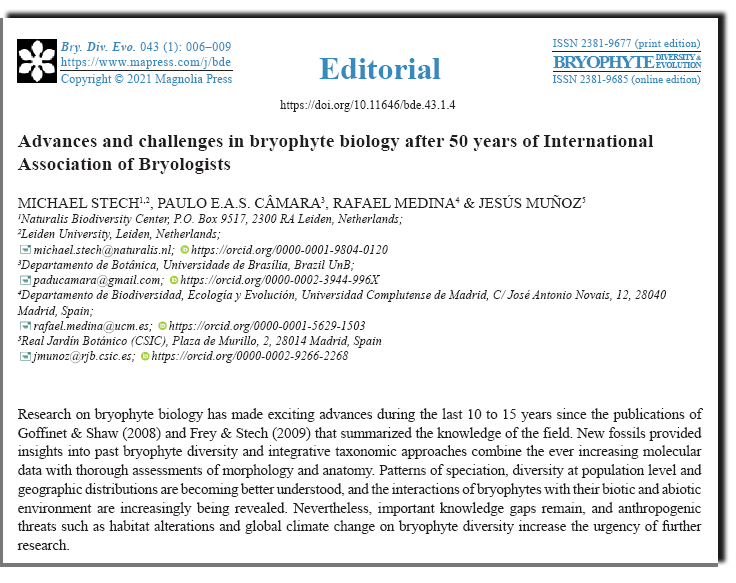Abstract
Research on bryophyte biology has made exciting advances during the last 10 to 15 years since the publications of Goffinet & Shaw (2008) and Frey & Stech (2009) that summarized the knowledge of the field. New fossils provided insights into past bryophyte diversity and integrative taxonomic approaches combine the ever increasing molecular data with thorough assessments of morphology and anatomy. Patterns of speciation, diversity at population level and geographic distributions are becoming better understood, and the interactions of bryophytes with their biotic and abiotic environment are increasingly being revealed. Nevertheless, important knowledge gaps remain, and anthropogenic threats such as habitat alterations and global climate change on bryophyte diversity increase the urgency of further research.
Downloads
References
Bell, N., Kariyawasam, I., Flores, J. & Hyvönen, J. (2021) The diversity of the Polytrichopsida–a review. Bryophyte Diversity and Evolution 43 (1): 98–111. https://doi.org/10.11646/bde.43.1.8
Câmara, P.E.A.S., Carvalho-Silva, M. & Stech, M. (2021) Antarctic bryophyte research–Current state and future directions. Bryophyte Diversity and Evolution 43 (1): 221–233. https://doi.org/10.11646/bde.43.1.16
Carey, S.B., Kollar, L.M. & McDaniel, S.F. (2021) Does degeneration or genetic conflict shape gene content on UV sex chromosomes? Bryophyte Diversity and Evolution 43 (1): 133–149. https://doi.org/10.11646/bde.43.1.11
Dong, S. & Liu, Y. (2021) The mitochondrial genomes of bryophytes. Bryophyte Diversity and Evolution 43 (1): 112–126. https://doi.org/10.11646/bde.43.1.9
Feldberg, K., Gradstein, S.R., Gröhn, C., Heinrichs, J.†, von Konrat, M., Mamontov, Y.S., Renner, M.A.M., Roth, M., Schäfer-Verwimp, A., Sukkharak, P. & Schmidt, A.R. (2021) Checklist of fossil liverworts suitable for calibrating phylogenetic reconstructions. Bryophyte Diversity and Evolution 43 (1): 14–71. https://doi.org/10.11646/bde.43.1.6
Frey, W. & Stech, M. (2009) Marchantiophyta, Bryophyta, Anthocerotophyta. In: Frey, W. (Ed.) Syllabus of Plant Families. A. Engler´s Syllabus der Pflanzenfamilien, 13th ed., Part 3 Bryophytes and seedless Vascular Plants. Borntraeger, Stuttgart, pp. 13–263.
Goffinet, B. & Shaw, A.J. (2008) Bryophyte Biology, 2nd ed. Cambridge University Press, Cambridge.
Gradstein, S.R. (2021) 50 years of the International Association of Bryologists. Bryophyte Diversity and Evolution 43 (1): 10–13. https://doi.org/10.11646/bde.43.1.5
Hedwig, J. (1801) Species Muscorum Frondosorum, descriptae et tabulis aeneis lxxvii coloratis illustratae. J.A. Barth, Leipzig, 325 pp.
Henry, J.S., Lopez, R.A. & Renzaglia, K.S. (2020) Differential localization of cell wall polymers across generations in the placenta of Marchantia polymorpha. Journal of Plant Research 133: 911–924. https://doi.org/10.1007/s10265-020-01232-w
Henry, J.S., Ligrone, R., Vaughn, K.C., Lopez, R.A. & Renzaglia, K.S. (2021) Cell wall polymers in the Phaeoceros placenta reflect developmental and functional differences across generations. Bryophyte Diversity and Evolution 43 (1): 265–283. https://doi.org/10.11646/bde.43.1.19
Ignatov, M.S. & Maslova, E.V. (2021) Fossil mosses: what do they tell us about moss evolution? Bryophyte Diversity and Evolution 43 (1): 72–97. https://doi.org/10.11646/bde.43.1.7
Lewis, L.R., Ickert-Bond, S.M., Biersma, E.M., Convey, P., Goffinet, B., Hassel, K., Kruijer, J.D., La Farge, C., Metzgar, J., Stech, M., Villarreal, J.C. & McDaniel, S.F. (2017) Future directions and priorities for Arctic bryophyte research. Arctic Science 3: 475–497. https://doi.org/10.1139/AS-2016-0043
Linnaeus, C. (1753) Species Plantarum, vol. 2. Imprensis Laurentii Salvii, Holmiae, pp. 561–1200.
Mitten, W. (1851) A list of all the Mosses and Hepaticae hitherto observed in Sussex. Annals and Magazine of Natural History, series 2, 8: 362–370.
Ostendorf, A.K., van Gessel, N., Malkowsky, Y., Sabovljevic, M.S., Rensing, S.A., Roth-Nebelsick, A. & Reski, R. (2021) Polyploidization within the Funariaceae—a key principle behind speciation, sporophyte reduction and the high variance of spore diameters? Bryophyte Diversity and Evolution 43 (1): 164–179. https://doi.org/10.11646/bde.43.1.13
Patel, N., Medina, R., Johnson, M. & Goffinet, B. (2021) Karyotypic diversity and cryptic speciation: Have we vastly underestimated moss species diversity? Bryophyte Diversity and Evolution 43 (1): 150–163. https://doi.org/10.11646/bde.43.1.12
Patiño, J. & Vanderpoorten, A. (2021) Island biogeography: an avenue for research in bryology. Bryophyte Diversity and Evolution 43 (1): 206–220. https://doi.org/10.11646/bde.43.1.15
Patiño, J., Whittaker, R.J., Borges, P.A.V., Fernández‐Palacios, J.M., Ah‐Peng, C., Araújo, M.B., Ávila, S.P., Cardoso, P., Cornuault, J., de Boer, E.J., de Nascimento, L., Gil, A., González‐Castro, A., Gruner, D.S., Heleno, R., Hortal, J., Illera, J.C., Kaiser‐Bunbury, C.N., Matthews, T.J., Papadopoulou, A., Pettorelli, N., Price, J.P., Santos, A.M.C., Steinbauer, M.J., Triantis, K.A, Valente, L., Vargas, P., Weigelt, P. & Emerson, B.C. (2017) A roadmap for island biology: 50 fundamental questions after 50 years of The Theory of Island Biogeography. Journal of Biogeography 44: 963–983.
Pressel, S., Bidartondo, M.I., Field, K.J. & Duckett, J.G. (2021) Advances in understanding of mycorrhizal-like associations in bryophytes. Bryophyte Diversity and Evolution 43 (1): 284–306. https://doi.org/10.11646/bde.43.1.20
Proskauer, J. (1951) Studies on Anthocerotales III. 4. The genera Anthoceros and Phaeoceros. Bulletin of the Torrey Botanical Club 78 (4): 331–349.
Sawangproh, W. & Cronberg, N. (2021) Evidence for interspecific hybridization in bryophytes during pre-molecular and molecular eras. Bryophyte Diversity and Evolution 43 (1): 180–205. https://doi.org/10.11646/bde.43.1.14
Sousa, A. & Renner, S.S. (2021) An illustrated step-by-step protocol for investigating liverwort chromosomes. Bryophyte Diversity and Evolution 43 (1): 127–132. https://doi.org/10.11646/bde.43.1.10
Stanton, D.E. & Coe, K.K. (2021) 500 million years of charted territory: Functional ecological traits in bryophytes. Bryophyte Diversity and Evolution 43 (1): 234–252. https://doi.org/10.11646/bde.43.1.17
Vitt, D.H. & House, M. (2021) Bryophytes as key indicators of ecosystem function and structure of northern peatlands. Bryophyte Diversity and Evolution 43 (1): 253–264. https://doi.org/10.11646/bde.43.1.18


